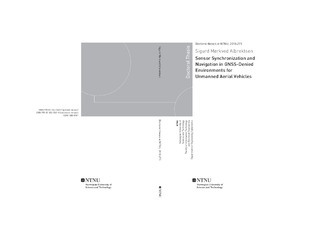| dc.description.abstract | In the last few years, the emergence of civilian unmanned aerial vehicles (UAVs) has sparked the interest of both the industry and the academic community. However, as systems become more popular and more widespread, the risk they represent increases as well. Today’s solutions rely heavily on global navigation satellite systems (GNSS), which have been shown to have several weaknesses against malicious attacks – the signal can either be blocked through jamming, or a fake position signal can be sent, tricking the UAV into thinking it is at another location through spoofing.
When developing a navigation and sensor solution for UAVs, there are two main considerations that must be made. The solution must provide accurate sensor measurements, and the UAV must be able to operate safely and securely in the mission’s environment. This thesis first presents a reconfigurable sensor timing and synchronization solution, intended for use in UAV payloads, with two implementations. This solution reads the timeof- validity (TOV) from different sensors and attaches these as timestamps to the sensor’s data messages. The solution can also be integrated with sensors such as cameras by triggering when they should capture images and storing the TOV through the camera’s flash output. The solution’s operation is verified through tens of experiments with beyond visual line of sight (BVLOS) fixed-wing UAVs, and an implementation has been shown to give 1.90 μs drift per second, with a resolution of 10 ns.
To make a UAV navigation solution that is robust to the single point of failure (SPOF) that GNSS represents, and to allow operation in GNSS denied environments, solutions for GNSS-free navigation is discussed in the second part of this thesis. First a camera based optical flow solution is presented, that enables throw-and-go functionality, which is verified through an implementation on a small multi-rotor UAV.
To enable navigation without GNSS for long-range, long-duration flights, a phased array radio system (PARS) is used as an absolute positioning sensor. First a solution with only the PARS and a barometer is presented, then these sensors are used to aid a nonlinear observer with an IMU and magnetometer. A root mean squared accuracy of 27m was achieved with the first solution, and a root mean square accuracy of 13m was achieved with the second solution.
Finally, a GNSS-spoofing detector was implemented that automatically detects spoofing and selects the best available solution of a highly accurate real-time kinematic (RTK) GNSS solution, which is sensitive to jamming, and a PARS NLO solution, which is highly robust, but less accurate. | nb_NO |
